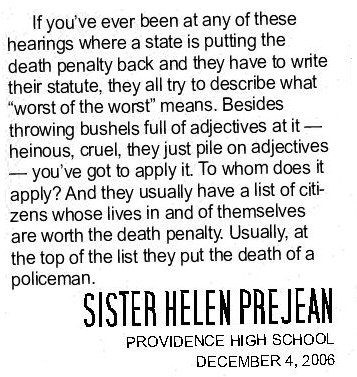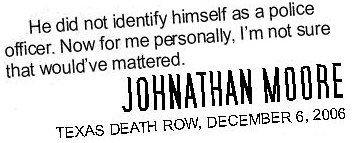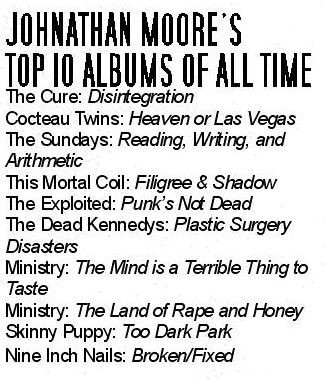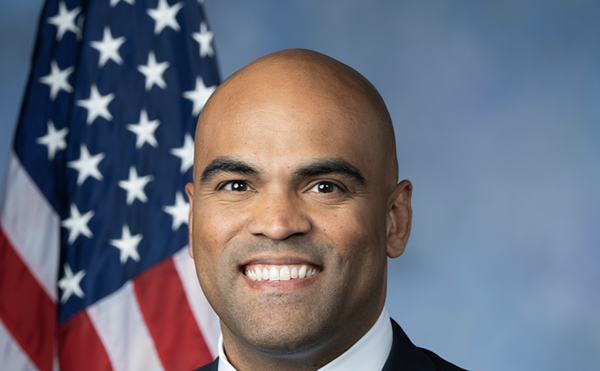If you read this on Wednesday, Johnathan Bryant Moore will most likely be alive. If you read this any day after, he will probably be dead.
There will have been no zero-hour reprieves for Officer Fabian Dominguez’s killer, no Supreme-Court intervention, no silence-shattering call from the governor’s office. There will have been no late-breaking innocence claim, no significant extenuating circumstances, no issue of mental retardation or other constitutional refuge.
Shortly before dawn on January 15, 1995, Moore and two friends, Peter
Dowdle and Paul Cameron, were caught in the act of burglary by an off-duty police officer. It was their second time that night at the house on Country Flower road. The officer did not call it in.
“... from seeing his face for the first time to him being killed was less than 10 seconds ... `Dominguez` is over here yelling ‘Put your fucking hands up’ ... I’m in the passenger seat looking at Pete with his hands up. Paul’s in the back seat hunched over with his hands up. He doesn’t want to be seen but at the same time he’s going to have his hands hidden ... I started thinking, ‘Fuck this. Fuck this car. I should’ve used my own vehicle, I should’ve been driving.’
“... I’m getting sick ... the adrenaline is surging, ... I’m looking for a way out ... get him to let down his defense so perhaps I could make a run for it ... and as I’m turning my face in his direction ... he takes the pistol back out and places it against my forehead ... then he’s screaming at me now, ‘Throw your fucking hands up’ and the less-than-10-seconds is about to end ...”
Moore pushed the gun against the dashboard, pulled his own .25 Lorcin pistol from his baggy skateboarder pants and shot wildly. The bullet entered the officer’s right eye and lodged in his brain.
“... I really start screaming at Pete, ‘Drive this fucking car!’ ... Pete’s still got his hands up and he’s crying, and Paul, he’s in the backseat and he’s still got his hands up and he says, ‘He can’t, John’ ... the keys were out on the lawn and now I’ve got to go get them ... it’s still pitch black ... This is still going fast ... His gun had fallen on the floor board ... I pick it up, step out ... run around `Dominguez` looking for something shiny in the grass ...
“... I don’t feel threatened by the man on the lawn anymore but I’m still angry and sick of the whole situation ... feelings and ideas start running through my head ... Maybe I just made him into a vegetable, maybe I should just finish him off. If he’s still alive maybe he can come after me ... the large idea was in my head, ‘If you just put a loaded gun at my head, you’re going to get it’ ...
“... and as I was walking by I casually pointed the pistol in the direction of his head and pulled the trigger ...”
Moore shot Dominguez three more times in the left side of the head with the officer’s semi-automatic, and the three fled the scene. Two days later, Moore was caught at the end of a 20-mile car chase. He was 20 then, 32 on the day of his execution.
Moore was the first person sentenced to death in Texas for the murder of a police officer since the death penalty was reinstated in 1974. The prosecution’s case was impenetrable: They recovered both murder weapons and most of the stolen property, and the police secured confessions from all three men. That locked Moore’s conviction. But the prosecution’s portrayal of Moore as a malicious youth fascinated with death and obsessed with killing cops sealed his death sentence. Ironically, Moore’s lawyers used this same irrational hatred for policemen to support his insanity defense.
Moore made the mistakes every Hollywood crime film warns against: he packed heat when it was unnecessary, he got greedy and returned to the crime scene. There were other mistakes as well. A courthouse parking attendant testified that a juror told her Moore had sabotaged his insanity defense when he fired his lawyers and attempted to defend himself. He seemed too competent. His defense attorney, Rusty Guyer, says that Moore’s escape attempts during the trial convinced the jury of his future danger to society. Some would say none of that matters. It was, it is, it will have been a done deal.
A mitigation investigator, a woman who researches the lives of capital-case defendants, once told me, “I’ve never had a client wasn’t a victim of something.”
In a sense, Moore was a victim of the ’90s.
It was Clinton’s era, a gap in history when no generation-defining cause inspired the youth to action. The economy was strong and America’s war involvement minimal, leaving the nation in a state of calm and contentment. Satisfaction led to complacency, and as a result, traditional culture began to erode itself: divorce seemed as commonplace as marriage, psychiatric medication as effective as diligent parenting; the mall more holy than the church.
It’s almost as if the “Teenage Wasteland” of The Who’s “Baba O’Riley,” and all the dystopic condemnations of punk rock that followed, had failed to materialize in the ’70 and ’80s, only to become a nightmarish reality, far worse for its repressive blandness, in the ’90s. For youth who rejected their parents’ lives — the cubicle jobs and dysfunctional relationships — alternatives were in short supply and idealism unrewarding. The white teenager chose the only other option: to do nothing. Later the internet would provide some relief, but in the meantime, the teenage fringe found escape in mall-ratting, Renaissance festivals, mind-contracting drugs, and half-hearted experimentation in Wicca and occultism. High-school-age suicides hit a high plateau in the first half of the decade.
In 1991, Nirvana’s Nevermind predicted and fueled the fall-out. That same year, Richard Linklater articulated the angst with his films Slacker and Dazed & Confused. A couple years later, Oliver Stone scratched the itch with Natural Born Killers. With the Columbine Massacre of 1999, the decade of suburban alienation, the age of the slacker and the trench-coat mafioso, would end.
“My senior year, I was an odd man out. I had no friends,” Moore said. “The Columbine kids, when that case happened, it sucks it happened, but I really identify with those characters because that was me. I actually did have a black trench coat, listened to the same music, all that stuff, was picked on, didn’t have a solid base of friends, a social network.”
As a teenager, Moore had attempted suicide, overdosed on Xanax, been in and out of trouble with the law for petty theft, and as a result, he’d spent two months in a psychiatric hospital.
In the ’90s, witch-hunts once again came back into style. In 1993, three boys who would be known as the “West Memphis three” were convicted for the murder of three children. The state’s argument rested heavily on their tastes in music — Metallica — as well as their library lists, which included occultist Aleister Crowley.
In the case of Moore, Dowdle, and Cameron, prosecutor Mark Luitjen, for whom the case would be a major rung on his climb to the district-judge seat, once described the trio in court as “the unholy trinity — the apostles of death.” Leading up to, and during, the trials, the police and prosecutions spoke of dark lifestyles, linking tattoos, body piercings, colored hair, and notebook doodlings with Satanism. The San Antonio Express-News took the prosecution’s bait and hypothesized on the correlation between Moore’s taste in music, specifically The Cure, and his supposed fascination with death. A witness for the prosecution also claimed that Moore had once tied a cat to a chair and thrown it into a pool, and so the newspaper enlisted psychologists to speak about connections between murder and animal cruelty. Moore’s friends testified that the boys had discussed murdering police officers (three years earlier Ice T’s Body Count released the single “Cop Killer”), which the prosecutors spun into an obsession. The defense simultaneously presented evidence that Moore had negative childhood experiences with law-enforcement.
Rick Martinez, too new at the Express-News to even have business cards, was assigned to dig up a fresh perspective. His story got him hauled before a grand jury.
“What got me interested was the fact that `the SAPD` had an assistant chief who was just throwing in all kinds of rhetoric, like they were riding the streets, looking for a cop to kill, found Dominguez and caught him vulnerable, and killed him,” Martinez says 12 years later. “I just didn’t believe that hyperbole. So rather than go back to the cops, I started looking for the friends of these guys.”
He returned with a thoughtful feature, portraying the three as the “kind of people who liked movies, parties, and Nintendo tournaments.” Dowdle was a student fascinated with psychology, who’d study even during road trips. Cameron was being primed for a supervisor position at a telemarketing firm.
“The way I read it at the time, was that Pete and Paul, they could’ve been any one of us. My read on Moore was that Moore was an older guy, kind of a geek, but he had to hang out with younger guys because maybe with his contemporaries he was a nut, but with younger guys he was kind of a cult figure.”
Now a sixth-grade teacher, Martinez remembers Moore’s friends were frightened of police retaliation. Indeed, that rings true with statements made in recent months regarding the case. Moore says he lied in his statement that he knew Dominguez was a cop because the police were threatening to charge his girlfriend with capital murder. Dowdle has always complained that Luitjen dragged out his case to break him so he would testify that Cameron had egged Moore on. In December, a witness in Cameron’s trial came forward to recant testimony regarding a videotape of a car-bombing in which all three boys allegedly participated. He now says the district’-attorney’s office blackmailed him with prosecution for another offense and promised favors down the road.
The grand jury was interested primarily in the back story Martinez reported. There was no shield law then (nor is there one now), and he was forced to hand over notes saying the homeowner’s daughter had set up the robbery.
“There was a divorce situation. The daughter was mad at the father, and so she tells these guys, ‘Hey, he always leaves the back door open and he’s got a young dog, and the dog’s real friendly,’” Martinez says. “She told them, ‘You park on the side of the house, you walk in the back door, you’ve got to go in through the sliding doors ...’”
Cameron is serving a life sentence, and Dowdle’s up for parole in July for a sentence that will end in 2020. Both maintained they would never have gone through with it if it hadn’t been a sure thing. Moore says the two 17-year-olds wouldn’t have been there if his usual accomplice wasn’t incapacitated on LSD.
“This was a group of slackers. They smoked a little pot, they drank a little beer, but they were not lawbreakers. The pipe-bomb, that’s pretty serious, but then again, it is something a stupid kid would do,” Martinez says. “The more I reflect on it, the more I can picture myself as one of those kids in that car.”
Moore’s court records are held in two 4-inch folders. In them, there’s only one juror’s questionnaire: that of the juror who allegedly spoke to the lot attendant. The survey says his favorite movie was Time Cop. His favorite TV show was Nash Bridges. His favorite album was Kenny G’s Duotones. The last book he’d read was by O.J. Simspon prosecutor Christopher Darden. He was a Democrat. He checked, “I would always vote for the death penalty in a case where the law allows me to.”
In the 1990s, the country was in love with tough justice, including mandatory sentences, three-strikes laws, and the death penalty. Nationally, according to the Bureau of Justice Statistics, the decade started off with 2,243 prisoners on death row. It ended with the all-time high of 3,601. Between 1991 and 1999, annual executions quadrupled. In 1995, a Gallup poll showed 77 percent of Americans favored the death penalty. Now, only 65 percent support it.
“No, it would be the same hard slog today,” says Guyer, a decade after he delivered Moore’s closing statement. “Look at it like this: The police officer, the worst you can say is he didn’t follow procedure. He deserves to die because he didn’t follow procedure? And here’s Johnathan, looking like Charles Manson.”
It’s the lunch rush at El Mirador in Southtown, and John Convery and Rusty Guyer are in fabulous moods. A couple of wrinkled veterans of criminal defense interrupt them with congratulations. The prosecution has just dropped all its charges in Convery’s federal embezzlement case; Guyer has just secured a “not guilty” in a federal gun-possession case.
Their demeanor sobers when they reminisce about Moore, who has recently received his execution date. Jury selection took two weeks. Convery thinks he recalls that when Moore was caught he was wearing a Charles Manson shirt. Guyer says Moore spent most of the trial with his head down or reading the Oxford English Dictionary. When Moore’s mother took the stand, she cursed at Luitjen, a scuffle broke out, and a bailiff said she bit him. Earlier in the trial, Moore was taken to the hospital for asthma treatment. Hidden in the restroom was a stun gun and pepper spray. The escape attempt failed.
Convery tells a story. He’s sorting through the evidence, the bagged remnants of Fabian Dominguez, a poem for Dominguez’s 8-month-old twin daughters in his police pad, and beside him a young officer eyes him with disgust. Convery baits him, saying he used to be a prosecutor and he believes, wholeheartedly, that life imprisonment is a crueler sentence than death. The officer explodes in something closer to a tantrum than a rage. An older detective in the room interrupts and tells the kid, “You’ll understand when you’re older.”
“We knew we weren’t going to get a ‘not guilty’ verdict off being insane,” Guyer says. “It was pretty loose, because it was basically a phobia of police and when the officer walks up he just simply goes into panic mode. Temporary insanity or whatever else, he doesn’t know the consequence of his acts.
“Well, yeah right. Who’s going to buy that? Who’s going to say ‘Oh yeah, you’re not guilty.’ But at least you begin to get that evidence in front of the jury, then proceed into punishment.”
The defense’s psychologists initially evaluated Moore as paranoid and depressed, but generally sane and competent. But when they saw his behavior in court, especially when Moore fired Convery and Guyer, then rehired them the next day, they changed their minds. By then it was too late.
Convery tells another story. He remembers shopping at the mall one weekend when a former juror recognizes him. San Antonio’s smaller than the census implies; it’s bound to happen. They get to talking, friendly-like, until the conversation naturally arrives at a juncture. In a roundabout way, then more directly, the former juror prods Convery to admit that, in her place, he would have chosen the death penalty. Convery tells her, “You’ll have to live with it. I can’t absolve you.”
On October 24, 1994, the apartment where Moore lived with his girlfriend burned down. They lost everything they owned and had to couch-surf until the Red Cross offered to pay their first and last months’ rent at a new place.
“We chose an apartment that was an expensive one, the rent was higher and I had to hustle more,” he said. “I was a petty thief, basically. Stupid minor stuff, car stereos, every now and then a car.”
But not burglaries, he explained. The night Fabian was killed had been only his second burglary in three years. He says he was getting a job; his parents had stopped helping him financially after he’d dropped out of SAC the second time.
“They wanted to put me in a sink-or-swim situation ... so it led up to this situation at the house on Country Flower,” Moore said. “I couldn’t pass it up.”
As of print deadline, sources at the Texas Department of Criminal Justice said the Attorney General's office may grant a temporary stay due to weather conditions and the icing over of roads between Austin and Hunstville, where the execution is set to take place.






















